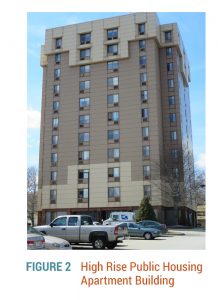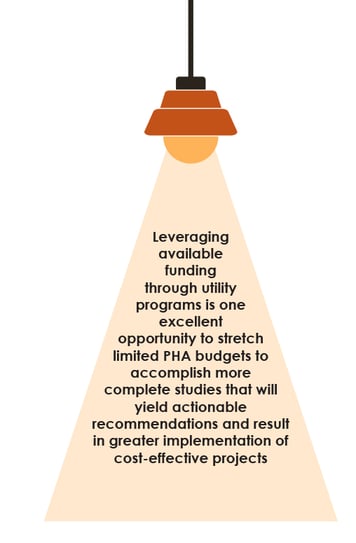- Home
- Services
- Hi-Line Engineering
- About
- Careers
- Contact
- Requests For Proposals
Green Physical Needs Assessments
by GDS Associates, Inc | March 4, 2016 | Newsletter - TransActions

GPNA
Across the United States, there are more than 1.2 million units of public housing managed by over 3,300 public housing authorities (PHAs). These affordable housing facilities range from scattered single-family houses to high rise complexes, and are located throughout central cities (61%), rural and non-metropolitan areas (21%) and suburbs (19%). Due to the size and scale of most public housing developments, they may be considered key accounts to utility companies and are a target for demand side management (DSM) and other customer benefit programs.
The vast majority of public housing facilities are over 30 years old and in continuous need of repair and refurbishment. To help guide the strategic planning process, the U.S. Department of Housing and Urban Development (HUD) has required public housing authorities with 250 or more units to conduct Physical Needs Assessments (PNAs) and all PHAs are required to conduct energy audits on a 5-year schedule, a requirement that has been in place for the past several decades. These assessments, though often addressing similar building systems, have historically been completed
independent of each other and vary widely in terms of depth of study and actionable recommendations. Rule 24 CFR 905 (2011) introduced the option of a Green Physical Needs Assessment (GPNA) which melds traditional PNAs and energy audits, extends the planning horizon from 5 to 20 years, and expands applicability from larger developments to all PHAs. This article explores the current and proposed requirements and compliance paths for PHAs, and how they fit within the purview of a DSM program and other utility efforts. As other types of commercial and residential facilities incorporate similar practices as public housing authorities, some of the findings may be applied to both commercial real estate and non-public housing multifamily developments.
Current HUD Requirements
Energy Audits (EAs)
Energy Audits have been required for all Public Housing Authorities on a rolling 5-year basis since 19962, however the actual requirements are vague and refer the PHA to state standards for energy audits. The industry standard audit report has a summary of existing building and equipment conditions and specifications, energy consumption baseline charts for all fuel types and water use, utility rate tariff and annual cost, and recommended energy and water conservation measures with estimated installed cost, high level energy savings calculations, and simple payback calculation. A detailed life-cycle cost analysis and actual project quotes are not required. More detailed interactive analysis of the energy conservation measures (ECMs) is not required. The quality of energy audit reports delivered by contracted consulting/engineering firms ranges significantly based on the approach, experience and qualifications of the energy auditor, as well as the objectives of the PHA as specified within their Request for Proposals (RFPs). Although the existing energy audit rule mentions a requirement to complete energy conservation measures recommended by the energy audit, there is no direction on “cost-effective” requirements, and the “as funds are available” statement establishes a loophole for not installing any ECMs recommended as some PHA operating budgets limit additional projects.
Physical Needs Assessments (PNAs)

Physical Needs Assessments have been a required part of large PHA operations for every 5 years since 1992, and can be an important first step of capital and operations planning. The HUD PNA utilizes a standardized data collection form and lists general actions required to bring the PHA developments up to modernization and energy conservation standards, assuming routine maintenance over a five year interval. PNAs generally require on-site inspections, review of documents, and resident input, and the deliverable includes a report with a description of the work needed at each
development as well as a cost estimate of the associated improvements. Qualifications requirements and recommendations are virtually non-existent for providers of PNAs, however it seems that historically a significant number of PHAs have hired Architecture and Engineering firms, consultants or contractors to do the work3. As with the energy audits, the cost, quality, and robustness of PNA deliverables varies based on PHA objectives, the time and effort expended as well as the approach, qualifications and knowledge of the auditor.
Funding Mechanisms
The cost to perform energy audits and PNAs are eligible for use of capital/modernization or operating funds. Many smaller PHAs incorporate the energy audit or PNA into their 5-year plans by including these costs into their operating expense. The cost to conduct these assessments is frequently a critical factor in defining a scope of work and selecting an auditor, often at the expense of thoroughness and quality. Leveraging available funding through utility programs is one excellent opportunity to stretch limited PHA budgets to accomplish more complete studies that will yield actionable recommendations and result in greater implementation of cost-effective projects. Energy performance contracts are another option for PHAs to complete more in-depth studies and large projects that the PHA may not be able to implement without the assistance of financing.
Proposed HUD Requirements
Green Physical Needs Assessments
In 2011, HUD proposed a set of three related Public Housing rules: Capital Fund Program, Physical Needs Assessment, and Energy Audit. The Capital Fund Program rule has been approved by HUD, and the proposed PNA and energy audit rules are still pending final approval. The most recent HUD message on the status of the proposed PNA rule (10/15/2015) states that the rule is currently on hold, however the current requirements of HUD for more than 250 units is still maintained as a requirement, and voluntary electronic submissions of the HUD GPNA Tool is strongly encouraged. The proposed PNA rule’s intent is to integrate Physical Needs Assessments with energy audits and was inspired by the already established HUD Mark-to-Market program. The proposed assessments are known as “Green Physical Needs Assessments,” or GPNA, as they will incorporate sustainability and energy auditing recommendations into a digital tool which is required to be uploaded to HUD on a PHA-specific and Asset Management Project – or development-specific level. A 20-year planning period is proposed rather than the current 5-year period since it better reflects the useful life of key building components and ensures long-term viability of a property. The goals of the proposed GPNA Energy Audit rule’s include:
- Providing more directions and consistency to energy audits performed by PHAs, allowing for ECM data to be entered into a GPNA Tool
- Establishing energy auditor requirements
- Integrating energy audits and PNAs for better capital and modernization planning.

The rule also introduces consistency within the categorization of ECMs to be reviewed by the energy auditor, differentiating between “Core” (required to be included, “low hanging fruit”) and “Advanced” ECMs (optional, alternative or experimental technologies and fuel switching), and inclusion of non-energy systems such as sustainability measures (i.e., low-VOC paints and impact on the environment or potential health benefits such as indoor air quality). The proposed rule requires use of a GPNA Tool and insertion of base and efficient equipment costs, incremental cost to
determine payback, as well as a detailed life cycle energy cost analysis including any ongoing operation and maintenance fees.
Conclusions
Utility providers with DSM programs should be engaging their PHA customers to understand where they are in the planning process and when the next 5-year plan will be due. There will often be cost-effective conservation measures from recent audits that have not completed and can be revived through more in-depth study, financial support, or a combination of the two. Some specific questions and topics to discuss are found in Figure 3.
Utility providers with DSM programs should be engaging their PHA customers to understand where they are in the planning process and when the next 5-year plan will be due
 For utility providers without DSM programs, there is still value in reaching out to PHAs and discussing where those customers are in their planning process and what their ultimate objectives are. There may be infrastructure/service improvements needed or fuel switches planned that could be supported. Additional technical support could also be provided to low-income energy efficiency program PHA participants to assist with funding of a HUD-compliant energy audit and implementation of cost-effective measures. For utilities without DSM programs, this is primarily an opportunity to build relationships with these key customers by understanding their obligations to HUD and supporting their short and long term energy goals.
For utility providers without DSM programs, there is still value in reaching out to PHAs and discussing where those customers are in their planning process and what their ultimate objectives are. There may be infrastructure/service improvements needed or fuel switches planned that could be supported. Additional technical support could also be provided to low-income energy efficiency program PHA participants to assist with funding of a HUD-compliant energy audit and implementation of cost-effective measures. For utilities without DSM programs, this is primarily an opportunity to build relationships with these key customers by understanding their obligations to HUD and supporting their short and long term energy goals.
For more information or to comment on this article, please contact:
 Sam Alpert, Engineer | CONTACT
Sam Alpert, Engineer | CONTACT
GDS Associates, Inc. – Manchester, NH
603.656.0336
DOWNLOAD PDF
Also in this issue: Protecting our Nation’s Electric Grid
GET OUR NEWSLETTER
RECENT POSTS
Archives
- December 2015 (8)
- June 2025 (7)
- January 2016 (6)
- July 2016 (6)
- March 2021 (6)
- May 2022 (6)
- August 2020 (5)
- March 2015 (4)
- January 2019 (4)
- June 2019 (4)
- August 2019 (4)
- February 2020 (4)
- May 2020 (4)
- June 2020 (4)
- December 2020 (4)
- July 2021 (4)
- October 2021 (4)
- April 2024 (4)
- December 2024 (4)
- May 2025 (4)
- April 2015 (3)
- August 2016 (3)
- February 2017 (3)
- July 2017 (3)
- February 2018 (3)
- February 2019 (3)
- November 2019 (3)
- March 2020 (3)
- April 2020 (3)
- September 2021 (3)
- December 2021 (3)
- August 2022 (3)
- December 2022 (3)
- April 2023 (3)
- July 2023 (3)
- December 2023 (3)
- September 2024 (3)
- October 2025 (3)
- May 2014 (2)
- February 2016 (2)
- March 2016 (2)
- September 2016 (2)
- November 2016 (2)
- January 2017 (2)
- July 2018 (2)
- November 2018 (2)
- March 2019 (2)
- May 2019 (2)
- July 2020 (2)
- September 2020 (2)
- April 2021 (2)
- August 2021 (2)
- October 2024 (2)
- September 2025 (2)
- February 2014 (1)
- April 2014 (1)
- July 2014 (1)
- August 2014 (1)
- November 2014 (1)
- February 2015 (1)
- May 2015 (1)
- June 2015 (1)
- November 2015 (1)
- October 2016 (1)
- December 2016 (1)
- October 2018 (1)
- December 2018 (1)
- April 2019 (1)
- July 2019 (1)
- September 2019 (1)
- October 2020 (1)
- November 2020 (1)
- February 2021 (1)
- April 2022 (1)
- July 2022 (1)
- October 2022 (1)
- August 2023 (1)
- October 2023 (1)
- July 2025 (1)
- November 2025 (1)
- December 2025 (1)
Categories
- Newsletter - TransActions (85)
- News (78)
- Employee Spotlight (35)
- Energy Use & Efficiency (28)
- Energy, Reliability, and Security (15)
- Other Specialized Services (11)
- Environment & Safety (10)
- Power Supply (8)
- Transmission (8)
- NERC (7)
- Utility Rates (7)
- Cyber Security (5)
- Energy Supply (4)
- Hi-Line: Utility Distribution Services (4)
- Battery Energy Storage (3)
- Uncategorized (2)
- Agriculture (1)
- Hi-Line: Seminars & Testing (1)